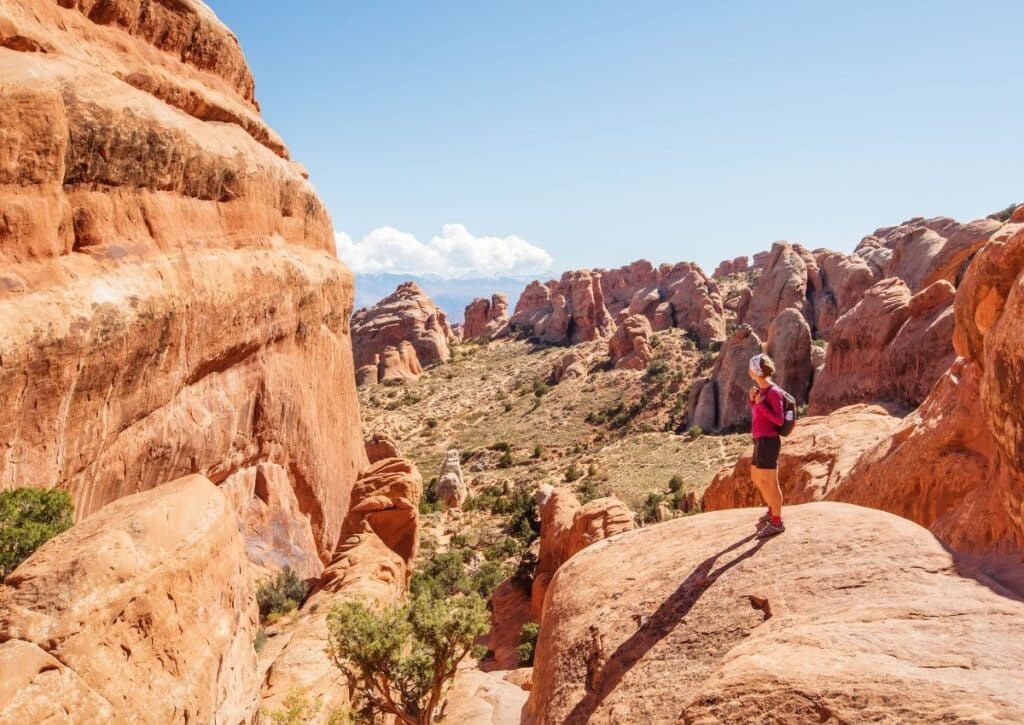Explore 21 animals in Arches National Park & their habitats in our guide with stunning hike photos. Perfect for wildlife enthusiasts!
Get ready for a wild journey through Arches National Park, where the stunning landscapes are alive with a variety of animals. In our latest adventure, we’ve spotted everything from mule deer to the elusive mountain lion.
This article is your all-access pass to the photos and stories of our encounters with the park’s native wildlife.
We’ve compiled a list of 21 animals you might see while hiking the park’s trails, complete with tips on where to find them.
Whether you’re a wildlife enthusiast or just love a good hike, join us as we dive into the diverse ecosystem of Arches National Park.
Brief Overview of Arches National Park
Arches National Park, nestled in the rugged eastern Utah landscape, is a sanctuary for a rich variety of wildlife species. Spanning over 76,679 acres, the park is globally renowned for its awe-inspiring sandstone arches and unique geological formations, creating an optimal habitat for a multitude of animals.
From the delicate beauty of the park’s namesake arches to the robust ecosystem thriving beneath the surface, Arches National Park offers a captivating exploration of nature’s wonders.
How to Reach
Whether you’re traveling by car, plane, or bus, getting to Arches National Park is a journey filled with scenic vistas. The park is located just north of Moab, Utah.
- By Air: The closest commercial airport is Canyonlands Field located about 20 miles from the park. Direct flights are available from Denver and Salt Lake City. From there, you can rent a car or take a shuttle service to reach the park.
- By Car: If you’re driving from the north or south, you can reach the park via US 191. The park entrance is located 5 miles north of Moab.
Why Visit
There are countless reasons to visit Arches National Park. The park houses over 2,000 natural stone arches, alongside a variety of unique geological formations. These natural wonders, coupled with the park’s diverse wildlife, make it a paradise for nature enthusiasts, photographers, and adventurers alike.
- Natural Wonders: Marvel at the largest concentration of natural stone arches in the world, including the famed Delicate Arch and Landscape Arch.
- Wildlife Viewing: Experience the thrill of spotting mule deer, desert bighorn sheep, and over 200 species of birds in their natural habitats.
- Recreational Activities: Embark on scenic drives, hiking trails, rock climbing, and stargazing opportunities under the clear desert skies.
Arches National Park is a world of contrasting colors, landforms, and textures. The park is divided into several areas:
- Entrance and Moab Fault: As you enter, you can witness the effects of the Moab Fault and view the Courthouse Towers.
- Park Avenue: This area is known for its towering sandstone cliffs resembling city skyscrapers.
- The Windows Section: This area contains a large concentration of arches and is one of the most scenic locations in the park.
- Devils Garden: Home to the Landscape Arch and a network of hiking trails, this is the spot for adventurers.
The park’s elevation ranges from 4,085 to 5,653 feet above sea level, and it’s characterized by a high desert climate, with hot summers, cool winters, and minimal rainfall.
The unique environment of Arches National Park supports a diverse range of wildlife, each adapted to thrive in the park’s specific conditions.
From its stunning natural beauty to the array of recreational activities on offer, Arches National Park provides a unique and unforgettable experience for all visitors.
Mule Deer
Among the shadows of the Park Avenue trail, the mule deer, recognized by its expansive ears, forages amidst the junipers and shrubs.
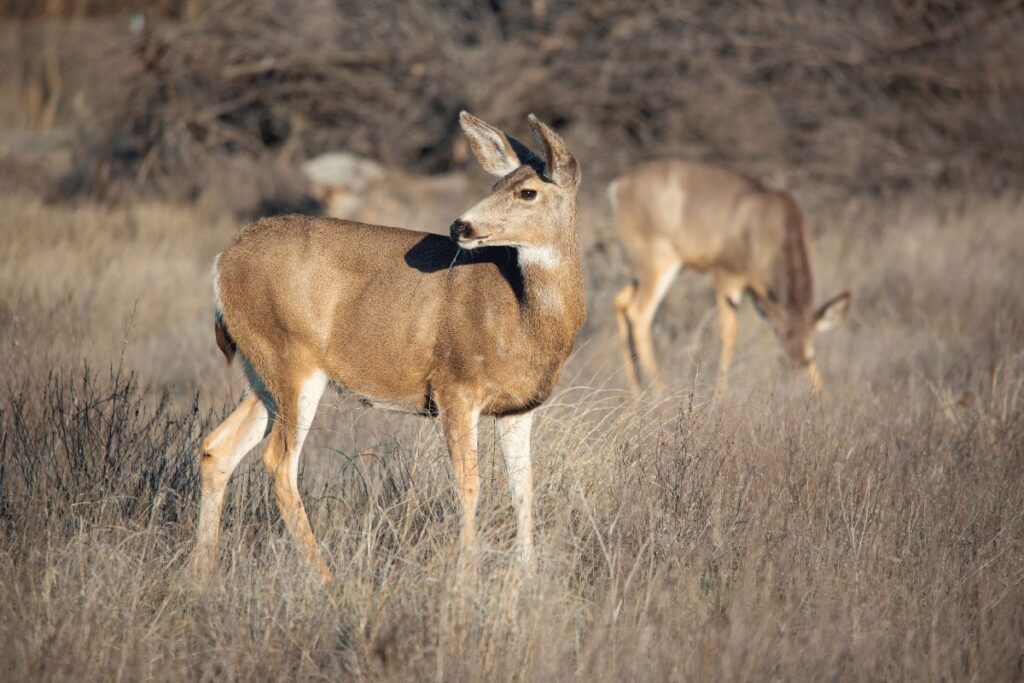
As the morning sun illuminates the Three Gossips formation, these graceful creatures can often be seen quenching their thirst from hidden creeks nearby.
While hiking towards Balanced Rock in the evening, one might observe a silhouette of a mule deer, casting a serene, ethereal presence against the iconic red arches.
This juxtaposition of wildlife and geology paints a vivid image of nature’s artistry in Arches.
During the mating season, bucks (male deer) will spar with each other for the chance to mate with does (female deer). Breeding usually takes place from November to December.
Fawns (baby deer) are born from May to June, after a gestation period of around 200 days. They weigh about 5 pounds at birth and are able to walk within a few hours. Fawns will stay with their mothers for several months before striking out on their own.
Coyotes
Arches National Park is home to a variety of fascinating animals, including coyotes. These canids are often seen running through the park in search of food.
Coyotes are opportunistic feeders and will eat just about anything they can find, including rodents, rabbits, snakes, lizards, and insects.
They also consume fruits and vegetables, which make up a significant portion of their diet during certain times of the year.
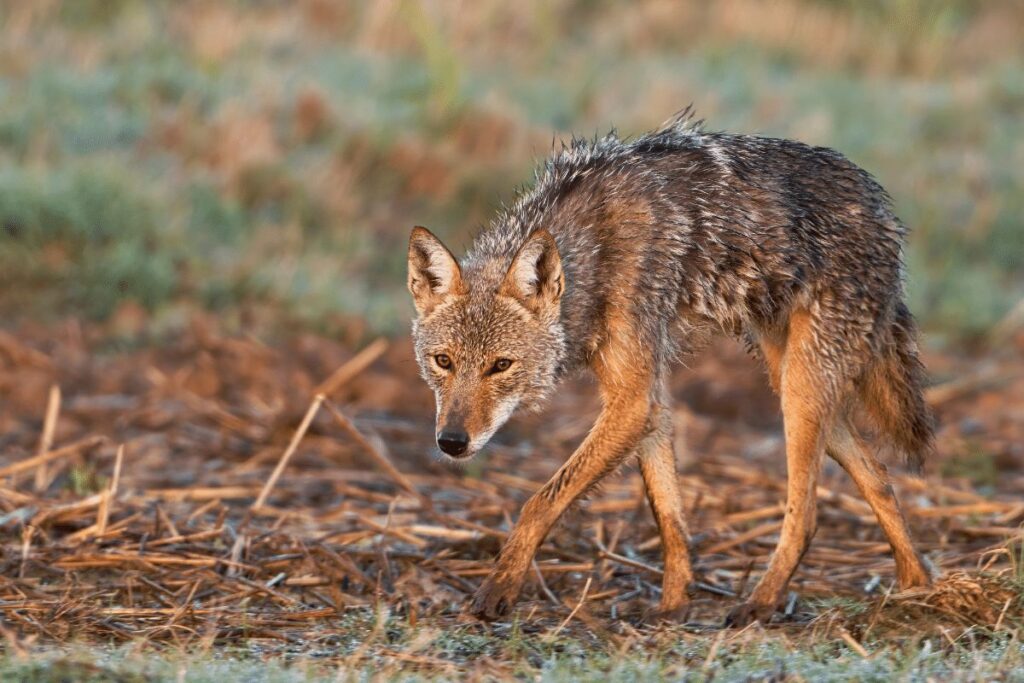
As twilight descends over the Fiery Furnace, a distinct, haunting howl of a coyote can be heard echoing off the labyrinth of narrow passages and towering fins.
These symbols of raw wilderness prowl around the Sand Dune Arch area, using the vast formations as cover while they hunt in the cool desert night.
The elusive nature of coyotes means that catching a glimpse of one, especially near the base of Skyline Arch, is a cherished memory for any park visitor.
Their presence seamlessly interweaves with the rugged beauty of Arches, embodying the park’s untamed spirit.
Porcupines
Porcupines are unique creatures are distinguished by their quill-covered bodies and their love of climbing trees.
Porcupines are surprisingly agile climbers, and they often use their sharp quills to help them grip onto tree branches.
If you’re lucky enough to see a porcupine in the wild, you’ll likely find it high up in a tree, munching on leaves or bark.
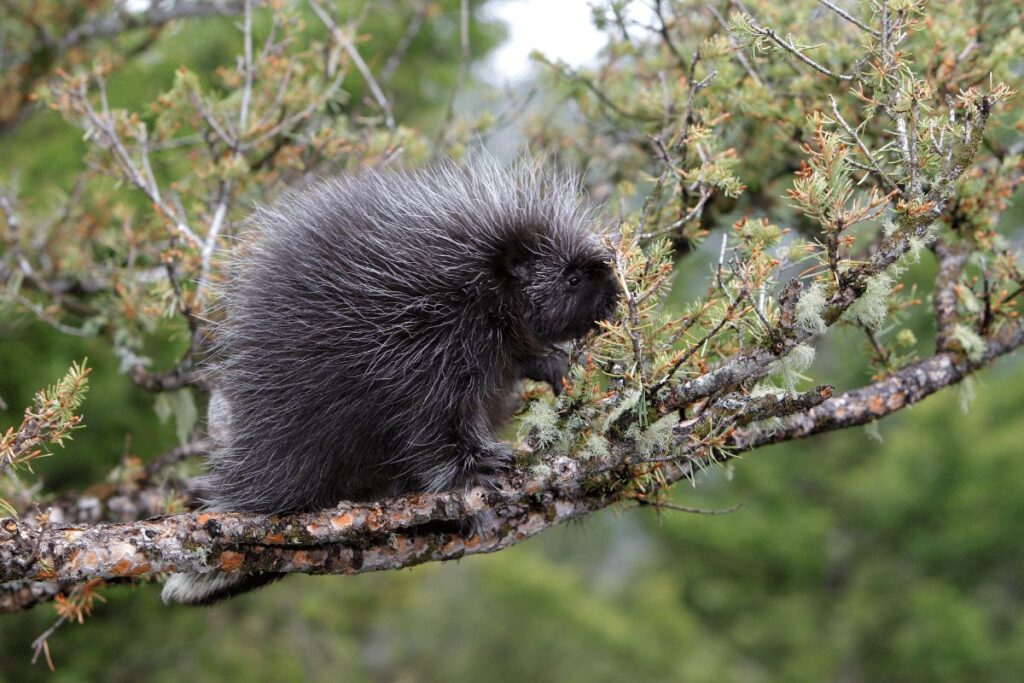
Amidst the quieter corners of the Windows Section, where pinyon pines and junipers intertwine, the porcupine can be found meandering.
Their quilled defenses, a stark contrast to the smooth red rock, often have them untroubled by predators.
At night, when the moonlight softly illuminates formations like Turret Arch, these creatures might be spotted gnawing on bark or seeking out water sources, their silhouette a slow-moving punctuation in the park’s nocturnal life.
If you’re planning on hiking in Arches National Park, be sure to keep an eye out for these interesting animals!
Desert Cottontails
These small, brown rabbits are often seen running and hopping around the desert landscape.
While they may appear to be timid, they are actually quite curious and will often approach visitors in search of a handout.
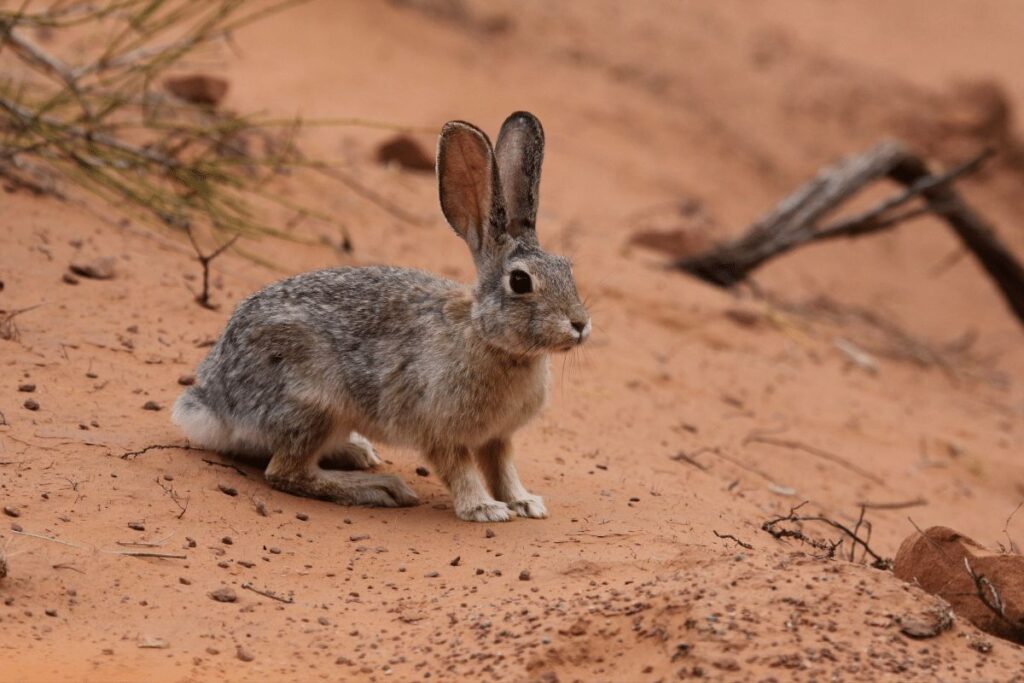
Desert cottontails are well-adapted to life in the desert. They can go without water for long periods of time and get the moisture they need from the plants they eat. In addition, their fur coats keep them cool in the hot desert sun.
The Garden of Eden, with its varied vegetation and scattered rock formations, becomes a haven for the desert cottontail.
As the sun begins its ascent, casting a warm glow over the La Sal Mountains Viewpoint, these small, agile creatures can be seen hopping about, their ears perked up in cautious curiosity.
Their swift, darting movements might occasionally lead them to the trail around Broken Arch, where their camouflaged fur allows them a brief, enchanting appearance to the observant visitor.
Black-tailed jackrabbits
These elusive creatures are seldom seen by humans, but their presence is nonetheless an important part of the park’s ecosystem.
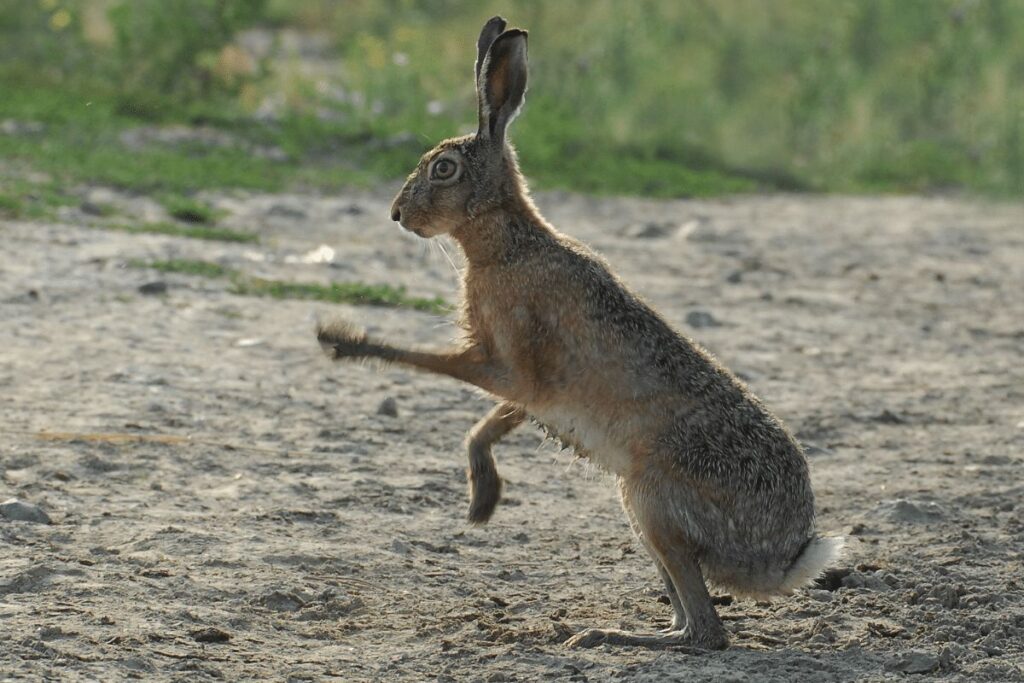
As their name suggests, black-tailed jackrabbits have black tails which they use to communicate with other jackrabbits.
Their large ears also serve an important purpose – they help the jackrabbits regulate their body temperature. Black-tailed jackrabbits are well-adapted to the harsh desert environment in which they live. T
hey are proficient swimmers and can go without water for long periods of time.
In the open spaces near Delicate Arch, the black-tailed jackrabbit reigns. With its distinctively long ears and powerful hind legs, it’s a sight to behold against the contrasting vibrant red rock and blue sky.
Often at dusk, as the last light of day fades over the Petrified Dunes, their silhouettes can be seen racing across the terrain.
These creatures, though common, become a magical part of the landscape when viewed against the backdrop of such iconic formations.
Desert Bighorn Sheep
Desert Bighorn Sheep are the most popular animal in Arches National Park.
As their name suggests, they live in deserts and are often seen in the park. They are a type of ungulate, which means they have hooves instead of nails.
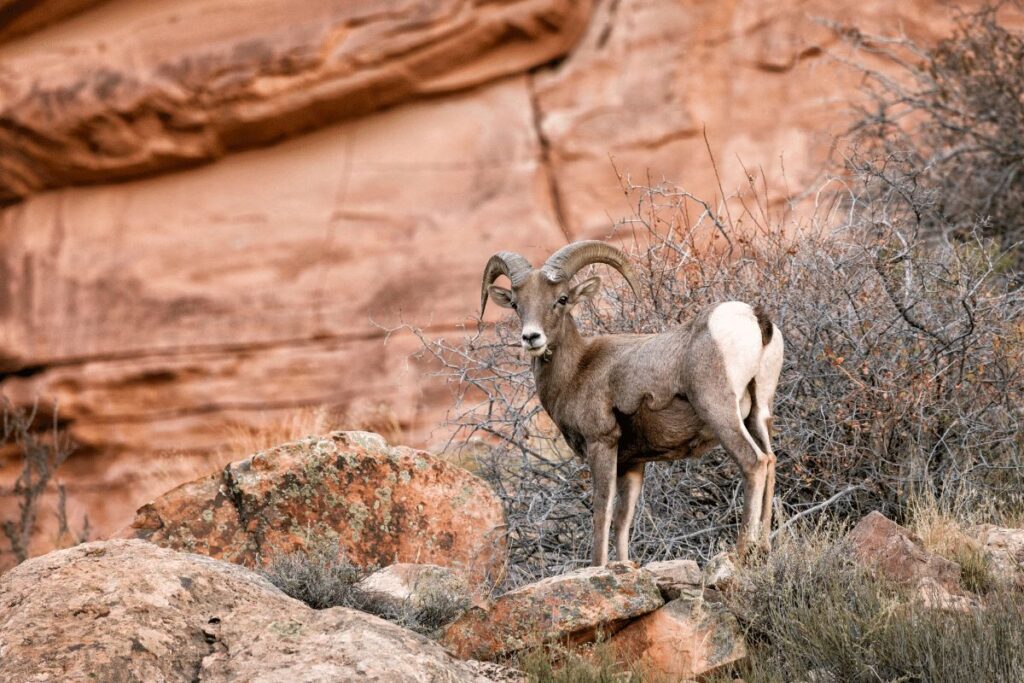
Bighorn sheep are very shy animals and will often run away when they see people. However, if you’re lucky enough to get close to one, you’ll be able to see how beautiful they are up close.
Their fur is a light brown color and they have white markings on their face and legs. Males (rams) also have large horns that they use to butt heads with other males during mating season.
Females (ewes) don’t have horns, but they are still an important part of the species. They give birth to twins or triplets and care for their young until they’re old enough to fend for themselves.
Navigating the steep and rugged terrain near the Devil’s Garden trailhead, the Desert Bighorn Sheep are a testament to adaptability.
Their curved horns and robust stature are highlighted against the backdrop of formations like Landscape Arch.
The sight of them effortlessly climbing the terraced rocks, especially during early morning hikes towards Double O Arch, is nothing short of spectacular.
These resilient animals have carved a life amidst the park’s challenging landscapes, serving as an embodiment of nature’s determination.
American Kestrel
The American Kestrel is one of the most widespread and familiar of all North American raptors. It is also one of the smallest, with a body length of about 9 inches and a wingspan of about 2 feet.
The adult male kestrel is mostly blue-gray above and rusty orange below, with a black band across the tail.
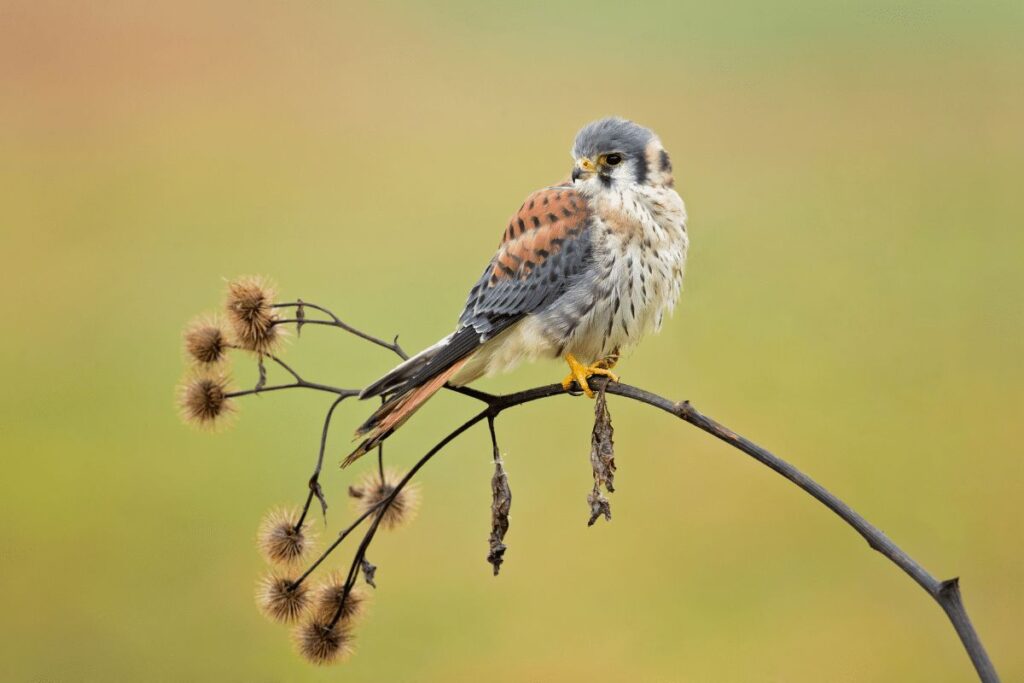
The female is similar but generally lacks the blue-gray coloration, instead being mostly rusty brown above and pale below, with spotting on the upper parts.
Both sexes have two vertical white stripes on the face, running from just below the eye to the base of the bill.
Kestrels are found throughout North America, from Alaska and Canada south to Mexico. They occur in a variety of habitats, including open woodlands, grasslands, farmland, urban areas, and even deserts.
In Utah’s Arches National Park, they can often be seen perched on power lines or fence posts along roadsides or hunting for prey in open areas such as parking lots or campgrounds.
Hovering above the vast plains around Panorama Point, the American Kestrel, with its distinctive pointed wings and sharp eyes, searches for prey.
The smallest falcon in North America, its vibrant plumage contrasts beautifully against the clear blue sky.
As visitors venture towards the Sand Dune Arch, they might witness this agile bird diving swiftly, capturing its prey in a magnificent display of aerial prowess.
In a land dominated by grand rock formations, the kestrel adds a dynamic touch to Arches’ vibrant ecosystem.
The Very Rare Mountain Lion
In the heart of Arches National Park, the mountain lion, also known as the cougar, casts a mysterious and majestic presence.
These apex predators, with their sleek tawny coats and mesmerizing gaze, traverse the labyrinth of red rocks and canyons largely unseen, embodying the very essence of wild solitude.
The trails leading towards Balanced Rock or the serpentine pathways near Fiery Furnace may bear the soft, indistinct footprints of this elusive creature.
Visitors might hear tales of a golden-eyed stare from atop a distant ridge or a soft, fleeting rustle in the underbrush—hints of the mountain lion’s ghostly passage.
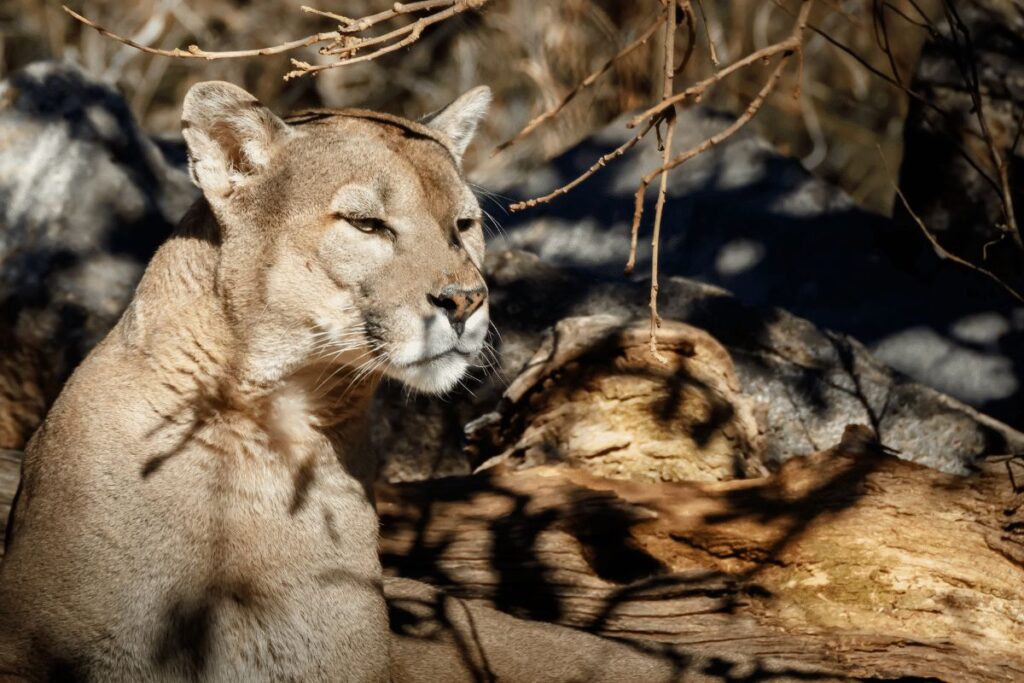
It’s not so much about direct encounters, but the profound realization of sharing space with such a powerful being.
The mountain lion’s presence is an underlying pulse in Arches, a whispered reminder of nature’s raw, untamed beauty amidst the stone arches and starlit skies.
A momentary glimpse, if one is ever so fortunate, of this magnificent animal lounging on a sun-bathed plateau or gracefully navigating the steep terrains near Double Arch, can be transformative.
The mountain lion, in its silent majesty, stands as a symbol of the wilderness that Arches National Park seeks to preserve, a testament to the intricate balance between man, beast, and nature.
Also Read: 15+ Top Guided Tours In The Arches National Park!
Horned lark
With the sprawling expanses of Arches National Park below and the vast sky above, the Horned Lark takes to the open terrains with unmatched vigor.
Distinguished by its subtle “horns” – feather tufts on its crown – this bird often frequents the open areas near the Salt Valley Overlook.
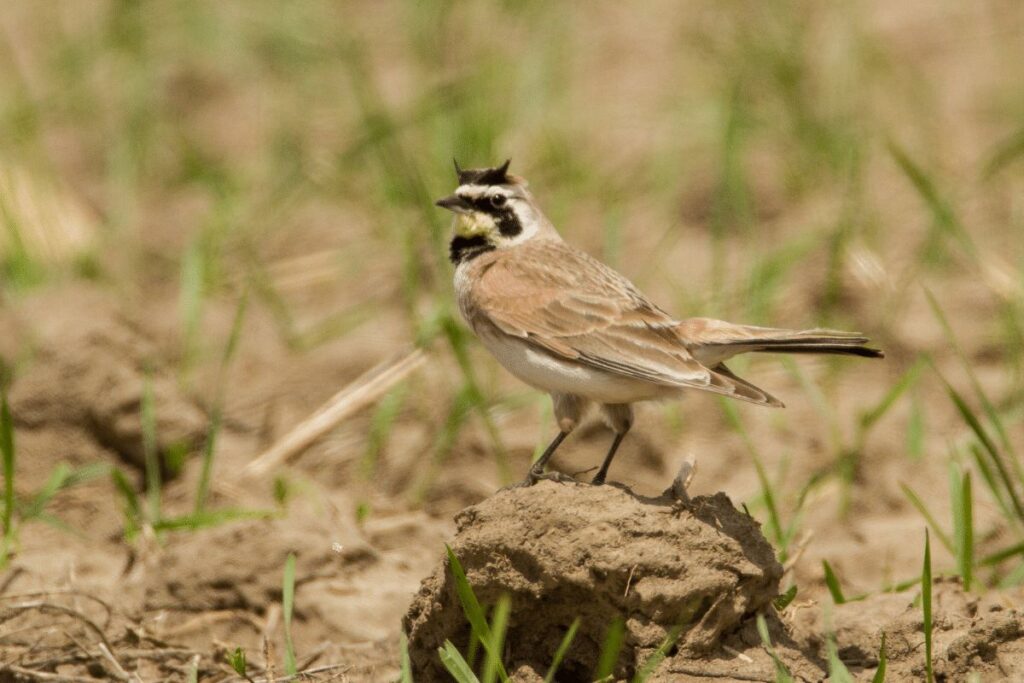
Their delicate, melodic calls can be heard resonating in the early morning, providing a soft musical backdrop to the park’s striking red vistas.
As you wander near the Park Avenue trail, you might spot these birds darting swiftly along the ground, leaving a trail of dust in their wake, an embodiment of the free spirit of the desert.
Great Blue Heron
These large wading birds can be seen stalking their prey along the edges of rivers and lakes, or standing motionless in shallow water as they wait to strike.
Herons typically eat fish, frogs, and small mammals, but will also eat reptiles, insects, and small birds.
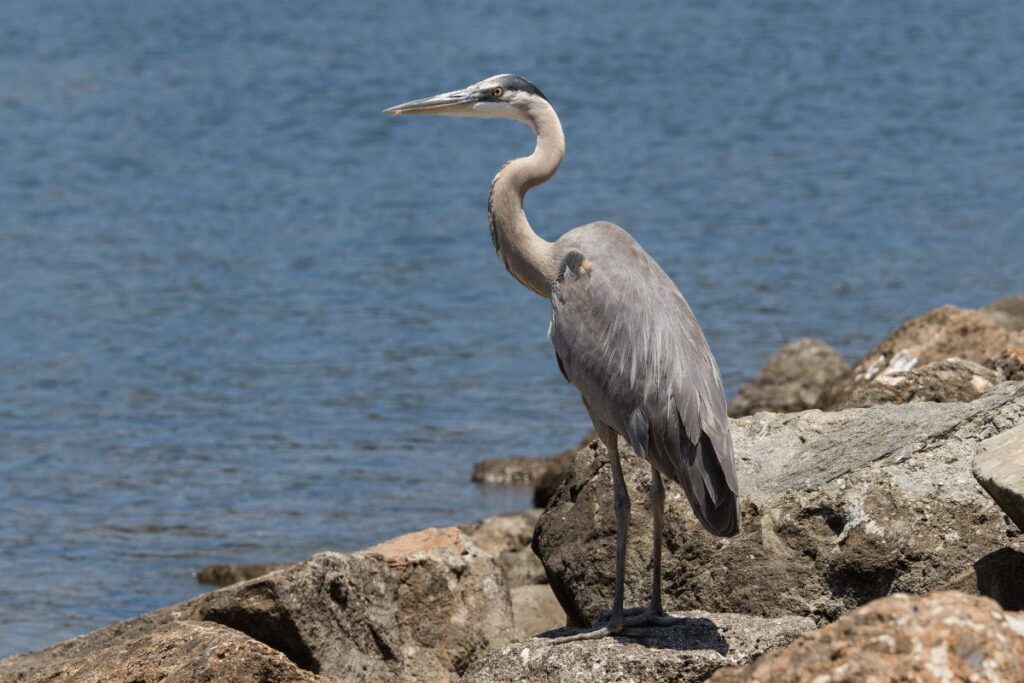
Even in a land characterized by stone arches and rugged landscapes, the sight of a Great Blue Heron gracefully alighting on the banks of ephemeral pools near Delicate Arch is nothing short of mesmerizing.
These tall, stately birds, with their blue-gray plumage and dagger-like bills, often search for fish in the park’s scarce water bodies.
A silhouette of a heron, with the La Sal Mountains in the backdrop, creates a surreal juxtaposition of delicate avian elegance against the park’s robust geology.
Burrowing Owl
Peering with bright eyes from their ground-level homes, the Burrowing Owls of Arches National Park offer a delightful sight for those exploring the Petrified Dunes.
Unlike most owls, these petite, long-legged birds are diurnal, often seen during the day standing erect near their burrows, surveying the desert landscape.
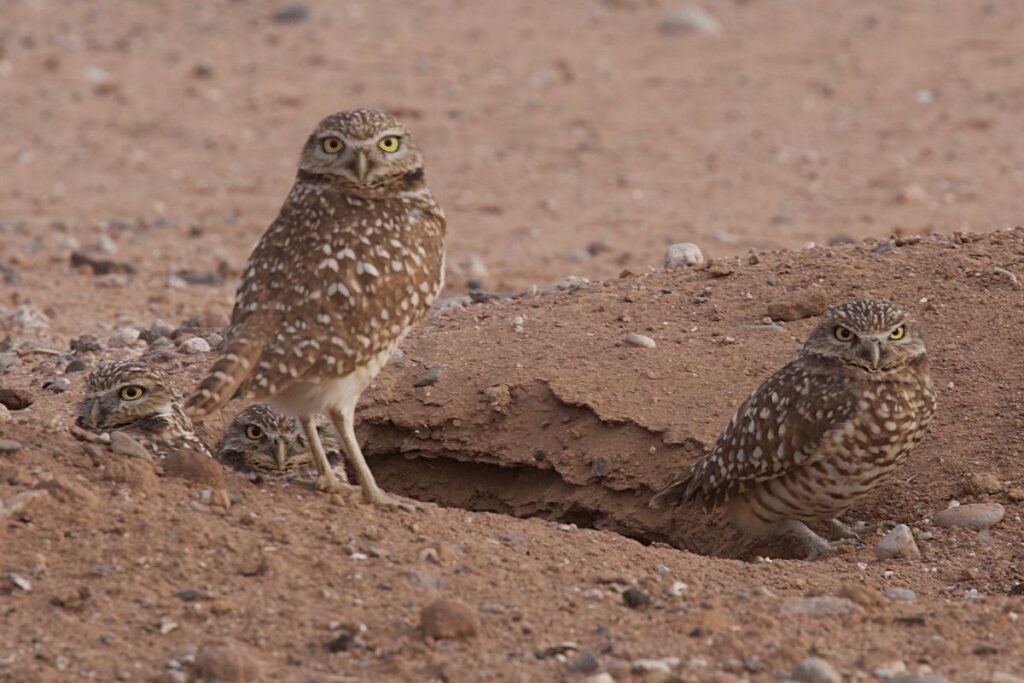
Don’t be fooled by their small size; burrowing owls are fierce predators. Their diet consists primarily of small mammals and insects, which they hunt from the safety of their underground homes.
Their presence near the Windows Section, with the magnificent arches towering above, is a stark reminder of the diverse life forms that thrive in this arid wonderland.
The sight of a Burrowing Owl, head tilting in curiosity, adds a touch of whimsy to the park’s vast terrains.
So if you’re hoping to catch a glimpse of one of these elusive creatures, your best bet is to go on a night hike.
Golden Eagle
This majestic raptor is one of the largest birds of prey in North America.
With its powerful wings and keen eyesight, the Golden Eagle soars above Arches National Park searching for prey, which includes mammals like rabbits and ground squirrels.
Look up, and you might spot one circling the sky or perched high on a rock outcrop.
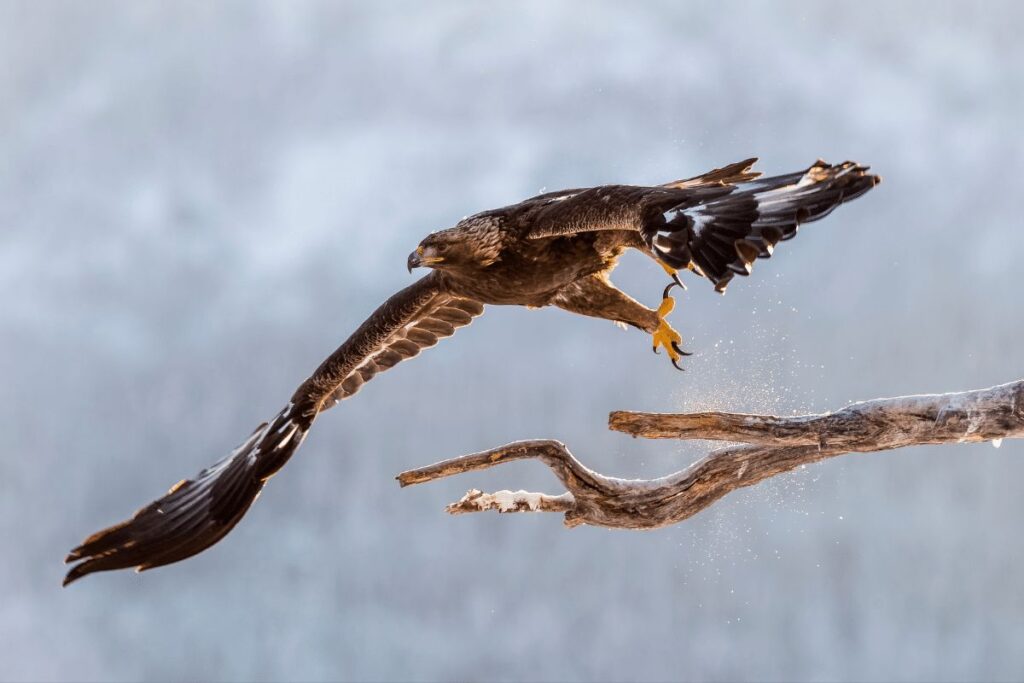
In Arches National Park’s vast expanse, Golden Eagles ride the thermals, their sharp eyes surveying the landscape below.
Amidst the park’s iconic stone arches, these mighty raptors find cliffs suitable for nesting.
They’re emblematic of the wild spirit of this region, and a keen-eyed visitor might spot one resting on Balanced Rock or soaring over Delicate Arch, adding to the natural drama of this unique landscape.
Red-Tailed Hawk
This iconic raptor is easily recognizable by its reddish-brown tail.
Often seen soaring in wide circles, Red-Tailed Hawks are common residents of Arches, hunting rodents, birds, and reptiles in the open desert and along the cliffs.
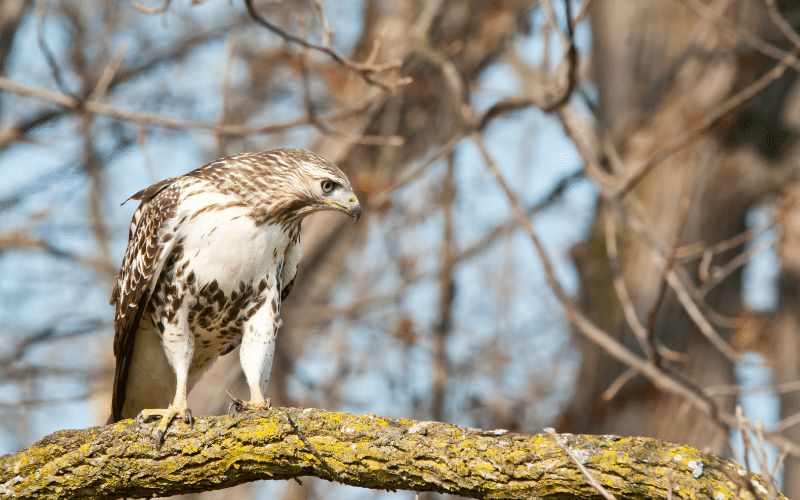
Against the backdrop of Entrada Sandstone formations, the Red-Tailed Hawk thrives in Arches National Park.
Its echoing cry resonates through canyons, as it circles Devil’s Garden, searching for prey amongst the junipers.
As visitors tread the winding paths, a silhouette of this iconic hawk might be seen perched atop the famous Landscape Arch, surveying its domain.
Peregrine Falcon
One of the world’s fastest birds, the Peregrine Falcon, is an awe-inspiring sight.
After making a remarkable recovery from endangered status, these falcons have chosen the high cliff ledges of Arches as their nesting ground.
In particular, the sheer cliffs around the Tower Arch area have become favored nesting sites.
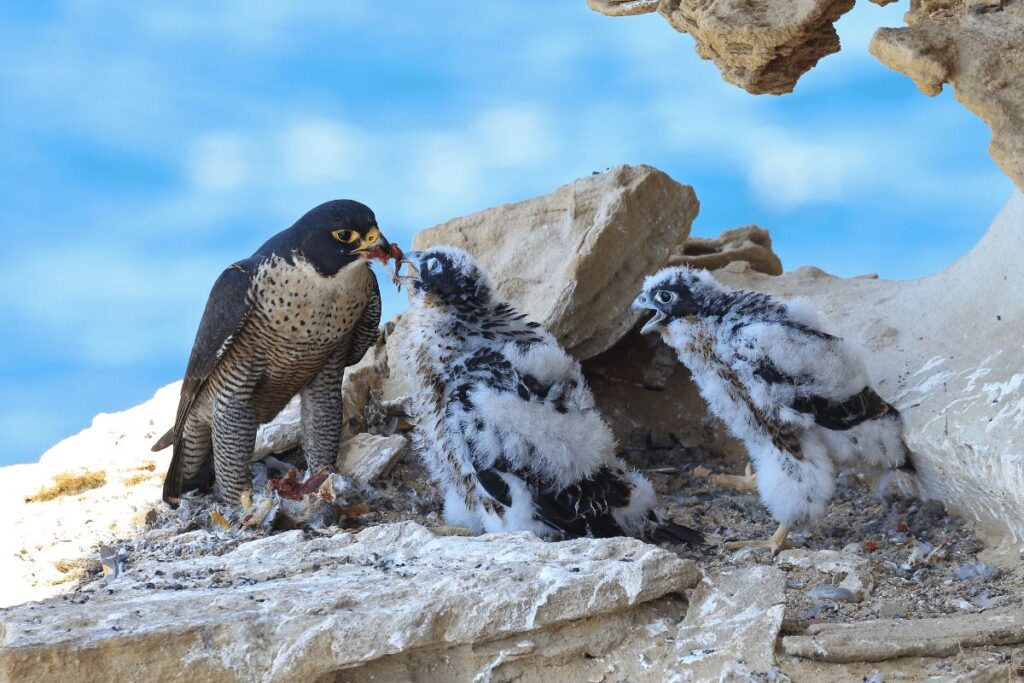
Near the Windows Section, their dramatic hunting stoops—where they can reach speeds of up to 240 mph—come to life as they swoop down, catching unsuspecting birds mid-flight.
Observing a Peregrine in this rugged landscape stands as a testament to nature’s resilience and grandeur.
Pinyon Jay
Often heard before they are seen, these loud and gregarious birds are closely associated with the pinyon pine forests found within the park.
Their diet mainly consists of pine seeds, and they play a vital role in seed dispersal.
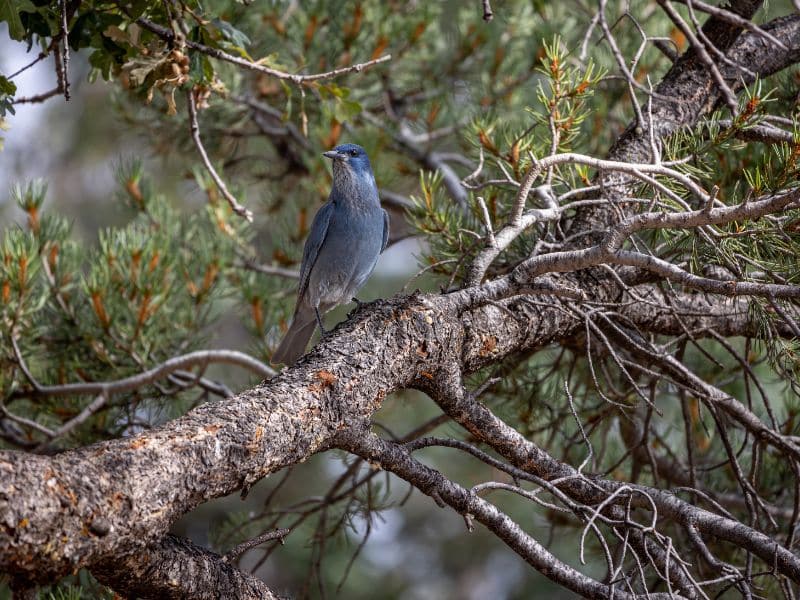
The Pinyon Jay’s raucous calls are a familiar sound around the park’s pinyon pine groves.
These sociable birds forage in groups, especially near Fiery Furnace, searching for pine seeds.
Their vibrant blue hue contrasts beautifully with the reddish rocks, especially around Sand Dune Arch, providing a splash of color in this arid landscape.
White-Throated Swift
One of the fastest flying birds, the White-Throated Swift can be seen darting around cliff faces and rock formations in the park.
They often nest on vertical cliff walls and catch insects in flight.
Zipping through the arches and canyons, the White-Throated Swift is aptly named, known for its rapid flight.
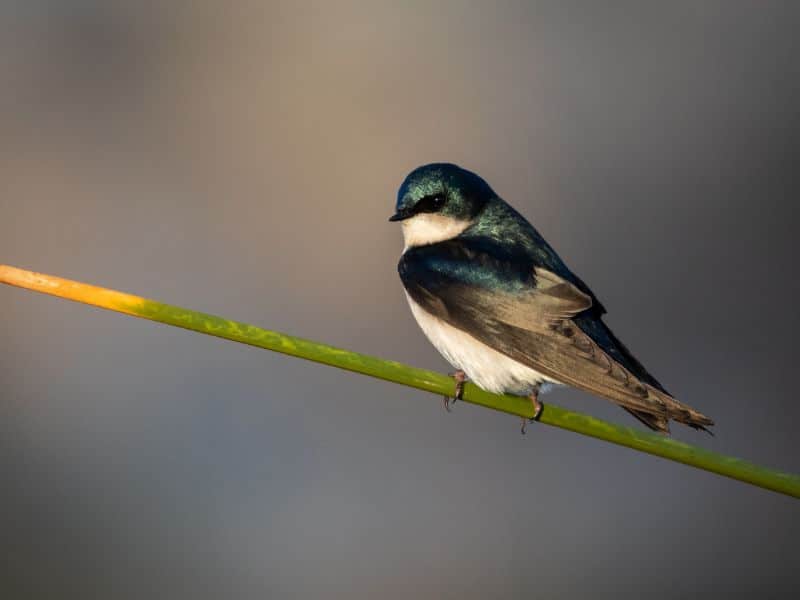
Particularly around Double Arch, these birds dive and weave, catching insects in the air.
Their nesting sites, often hidden in the nooks and crannies of the massive rock walls, echo with their sharp calls.
Common Side-Blotched Lizard
This small lizard is easily recognizable by the dark blotch behind its front legs.
Adaptable and widely distributed, they can be found basking on rocks or scurrying into crevices when threatened.
The rocky terrain around Broken Arch offers the perfect habitat for the Common Side-Blotched Lizard.
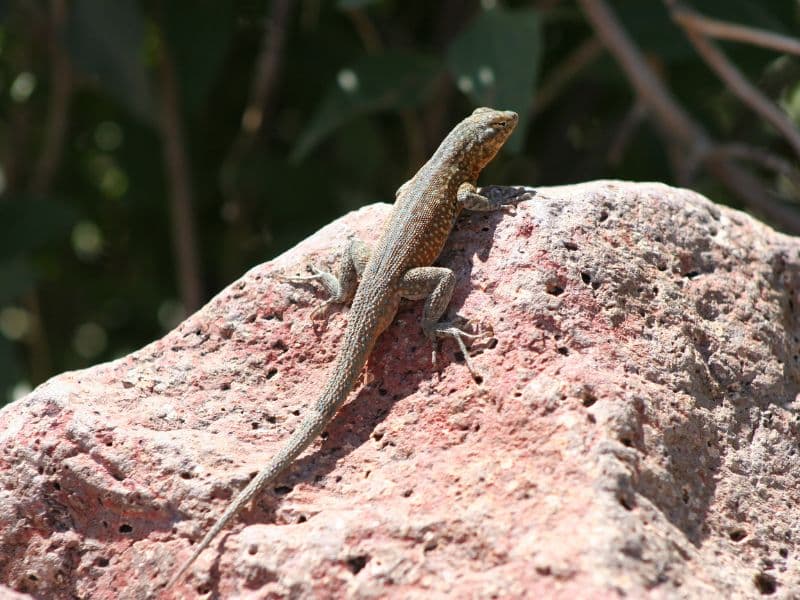
Their subtle coloration blends seamlessly with the desert hues.
On warmer days, visitors exploring the Petrified Dunes might spot these lizards basking under the sun, absorbing its warmth before darting into the shadows.
Midget Faded Rattlesnake
This venomous snake is the smallest rattlesnake species in Utah. While not commonly seen, visitors should always be cautious and watch their step.
They blend in well with the sandy and rocky environment of Arches.
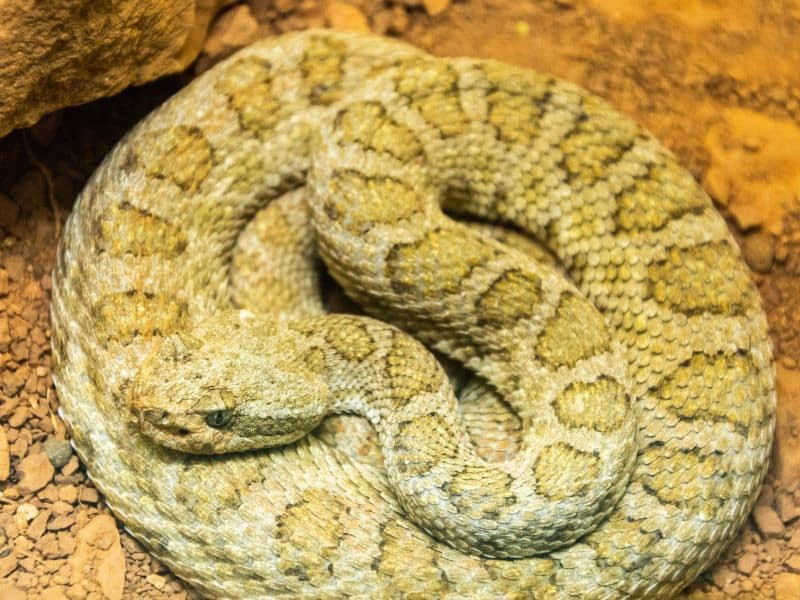
This elusive rattlesnake has evolved to camouflage perfectly with Arches’ sandy and rocky environment.
While not a common sight, hikers around the primitive loop trail should tread carefully, respecting this venomous inhabitant.
Their presence reminds us of the raw, untamed essence of the park.
Western Collared Lizard
Brightly colored and sometimes seen standing on its hind legs, this lizard is a sight to behold against the red rocks of the park.
They can be quite bold and are often a favorite among photographers.
Amidst the Garden of Eden rock formations, the vividly colored Western Collared Lizard can often be seen. Its bright hues juxtapose starkly against the red rocks.
Observers might even witness the peculiar sight of this lizard running on its hind legs, a behavior that’s as unique as the park’s arches.
Northern Plateau Lizard
With its grayish-brown coloration, this lizard is well camouflaged against the rocks and sands of Arches.
They are often found sunning themselves on rocks during the warm months.
The Northern Plateau Lizard finds sanctuary amidst the pinions and junipers near Skyline Arch.
Their grayish-brown scales allow them to remain inconspicuous, hidden from predators.
As visitors traverse the Park Avenue trail, they may be fortunate enough to encounter this native reptile, embodying the park’s quiet elegance.
Red-spotted Toad
Despite the arid environment, this toad can be found in the park after heavy rains.
Recognizable by its small size and red spots, this toad emerges from its underground hideouts to breed in temporary rain pools.
Following the rare desert rains, ephemeral pools around Tapestry Arch become breeding grounds for the Red-spotted Toad.
Their melodic calls pierce the night, adding to the park’s nocturnal symphony. These toads are a testament to life’s tenacity in one of Utah’s most breathtaking landscapes.
Also Read: 8 Things To Remember When Visiting The Arches National Park (Told By Rangers)
Conclusion
Our journey through Arches National Park was more than just a testament to nature’s architectural wonders; it was a vibrant canvas of life in all its diverse forms.
As we treaded the winding paths amidst towering arches and sprawling landscapes, it wasn’t just the stone giants that left us in awe.
From the swift dive of the Peregrine Falcon near the Windows Section to the gentle gaze of a mule deer grazing in the shadow of Delicate Arch, every creature added a unique brushstroke to our experience.
The elusive mountain lion’s distant footprints near Balanced Rock and the melodic call of the Horned Lark echoing through the Salt Valley Overlook painted tales of a land where life thrives amidst the challenges of a desert environment.
Each animal, from the graceful Great Blue Heron to the petite Burrowing Owl, narrated stories of survival, adaptability, and beauty.
As we conclude our narrative of Arches, it’s clear that the park isn’t just a sanctuary for awe-inspiring geological formations but also a haven for a myriad of creatures, each playing its part in the grand symphony of nature.
In the silent majesty of the rocks and the whispered tales of its inhabitants, Arches National Park stands as a profound reminder of nature’s resilience, grandeur, and intricate interplay.



